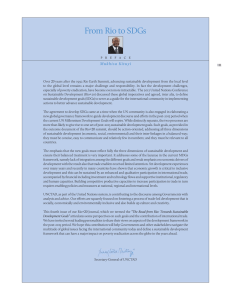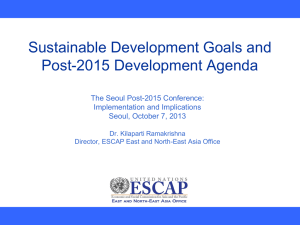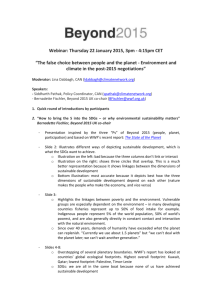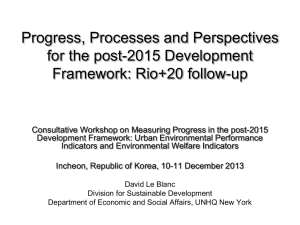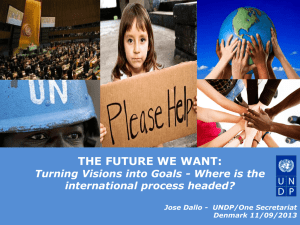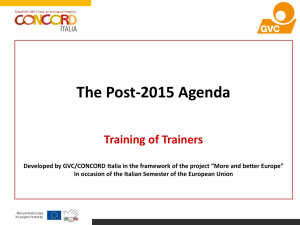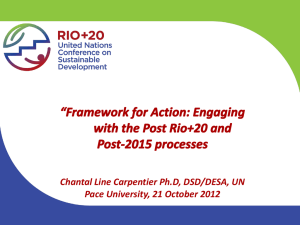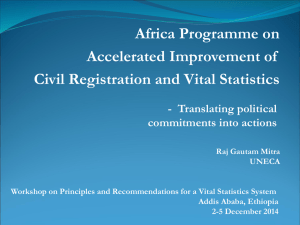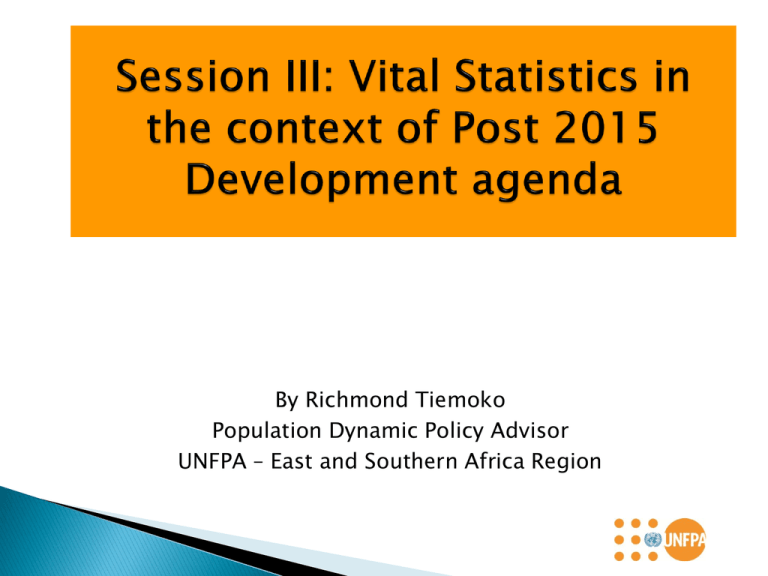
By Richmond Tiemoko
Population Dynamic Policy Advisor
UNFPA – East and Southern Africa Region
The outcome of the negotiations on post 2015 is expected to have different
components i) Political Declaration; ii) Sustainable Development Goal (SDG)
and Targets iii) Means of Implementation and new Global Partnership and; iv)
Monitoring and Reporting framework for the Post 2015 Development Agenda.
Disaggregated data by sex, age, locality is critical to the post 2015
development agenda.
To implement SDGs we need to improve the availability of and access to data
and statistics disaggregated by income, gender, age, race, etc.;
Without comprehensive CRVS, the data revolution may just be … data
evolution (without R).
Updated Vital statistics including cause of death is the way to improve
women’s health and reduce the unacceptably high maternal mortality.
The United Nations General Assembly will begin negotiations in
January 2015 on the outcomes for the Post 2015 Development
Agenda. Currently Member States, under the leadership of the
Permanent Representatives of Ireland and Kenya, are negotiating
modalities and scope for the negotiations, which are expected to
continue till the adoption of a comprehensive Post 2015
Development Agenda by world leaders in September/October
2015.
The outcome of the negotiations is expected to have different
components i) Political Declaration; ii) Sustainable Development
Goal and Targets iii) Means of Implementation and new Global
Partnership and; iv) Monitoring and Reporting framework for the
Post 2015 Development Agenda.
Post-2015 is critical for Africa’s agenda 2063 – relevance and
future of the will depend on our collective and personal
involvement to mobilize member states and build strategic
partnership with various stakeholders.
For Africa to perform in the context of Post-2015 , we would
need to review, improve and innovate in civil registration and
vital statistics; be focus and willing to deliver and to change our
mindset (from reactivity to pro-activity) toward vital statistics
while investing considerably in young people.
Post 2015 is an intergovernmental negotiation process aiming to
prepare/develop the new post-2015 development framework to
replace the MDGs
Rio+20
Post-2015 ongoing process since Rio+20 (2012)
Rio+20 outcome document set out a mandate to establish an OWG on
SDGs
Rio+20 : People are at the Centre of sustainable development and
promised to strive for a world that is just equitable and inclusive.. a
world without distinction of any kind such as age, sex, disability,
culture, race or other status.
Rio+20 reaffirmed the commitment to fully implement ICPD Plan of
action;
According to UN/DESA 2014 publication Population and vital
statistics report,:
The availability of detailed vital statistics for a country or area illustrates
national capacity in the compilation of these statistics from civil
registration systems
•
Out of 238 countries or areas, the latest available figure for live births
refers to year 2009 or later for 146 countries or areas (61 per cent); to
year 2007 or 2008 for 25 countries or areas (11 per cent) and to an
earlier year for 32 countries or areas (or 13 per cent). No data for live
births are available for 35 countries or areas (or 15 per cent) for the
period 1998-2012. The availability of data on (total) deaths is similar.
However, data on infant deaths are somewhat less recent.
• Only 9 countries in Africa are reported to have at least 90
percent completeness of live birth registration and 7 countries
record 90% completeness of death registration
Source:
Important progress made.
Despite this progress, only six African countries are on track
to achieve the MDG5 goal of improving maternal health by
2015.
Today, more than 60 per cent of women – 181,000 out of
289,0001 women globally – who die annually from
pregnancy related causes, are African women.
So why are so many African women dying in pregnancy
and childbirth? Much of the reasons are related to civil
registration and the protection of the rights of the women
and the girl child.
2014: Negotiations on SDGs through OWG co-facilitated by Kenya and
Hungary:
Main outcomes of OWG is a Report with 17 SDGs goals and 180 targets
(all 17 goals relevant to population and development)
Goal 3. Ensure healthy lives and promote well-being for
all at all ages
3.1 by 2030 reduce the global maternal mortality ratio to less than
70 per 100,000 live births
3.8 achieve universal health coverage (UHC), including financial
risk protection, access to quality essential health care services, and
access to safe, effective, quality, and affordable essential
medicines and vaccines for all
This cannot be achieved without a revolution in the production and
use of vital statistics
Goal 4. Ensure inclusive and equitable quality education and
promote life-long learning opportunities for all
4.5 by 2030, eliminate gender disparities in education and ensure
equal access to all levels of education and vocational training for the
vulnerable, including persons with disabilities, indigenous peoples,
and children in vulnerable situations.
Goal 5. Achieve gender equality and empower all women and girls
5.1 end all forms of discrimination against all women and girls
everywhere
5.3 eliminate all harmful practices, such as child, early and forced
marriage and female genital mutilations (withtut CR and VS we cannot
establish the age of the child and without VS we cannot address the
issue)
Goal 16:Promote peaceful and inclusive societies for sustainable
development
16.3 promote the rule of law at the national and international
levels, and ensure equal access to justice for all
16.9 by 2030 provide legal identity for all including birth
registration
16.b promote and enforce non-discriminatory laws and policies for
sustainable development
Goal 17. Strengthen the means of implementation and revitalize the
global partnership for sustainable development
Challenges
- No or limited data or factual evidence to be used on Post-2015.
- Limited collaboration between the various stakeholders
- Limited resource for vital statistics.
APAI_CRVS
Institutionalization of the conference of Ministers for CRVS
Decade of Statistical Development: Revolutionising Censuses and
Civil Registration and Vital Statistics towards Africa Agenda 2063”
Investment on data revolution and CRVS. NB: The SecretaryGeneral's Independent Expert Advisory Group on a Data Revolution
for Sustainable Development (IEAG) met with the UN SecretaryGeneral Ban Ki-moon to hand over their report 'A World That
Counts: Mobilising The Data Revolution for Sustainable
Development'
There is no data Revolution without
vibrant and strong vital statistics
I thank you for your attention


